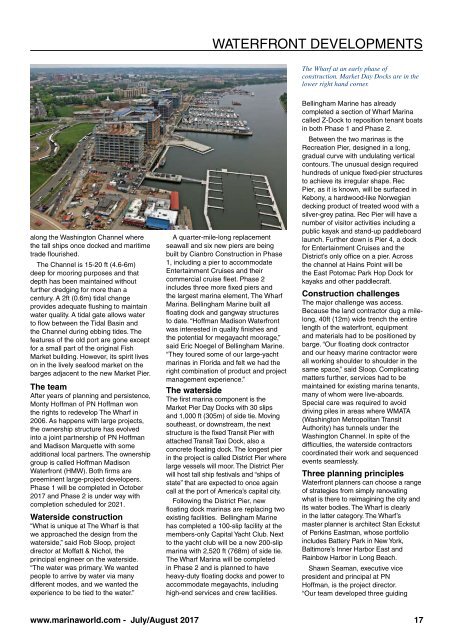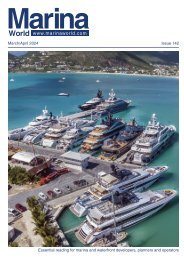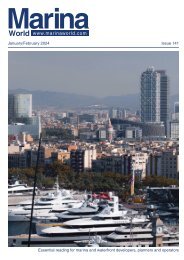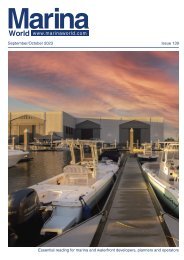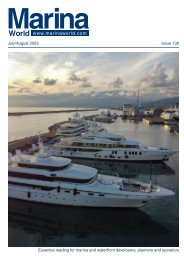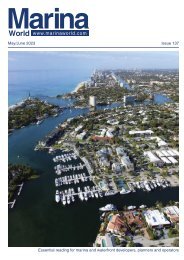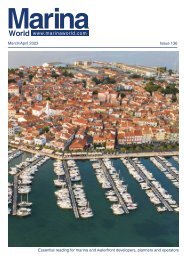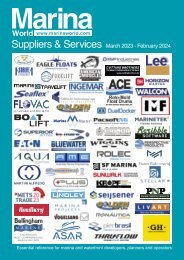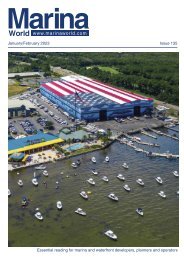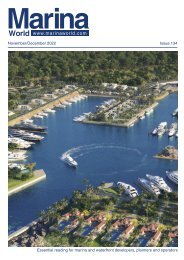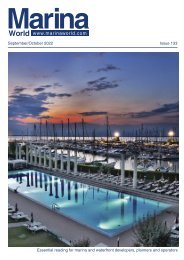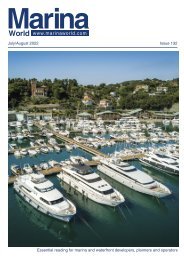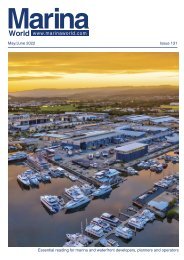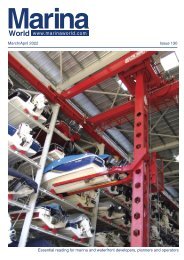2017 July August Marina World
The magazine for the marina industry
The magazine for the marina industry
You also want an ePaper? Increase the reach of your titles
YUMPU automatically turns print PDFs into web optimized ePapers that Google loves.
WATERFRONT DEVELOPMENTS<br />
The Wharf at an early phase of<br />
construction. Market Day Docks are in the<br />
lower right hand corner.<br />
along the Washington Channel where<br />
the tall ships once docked and maritime<br />
trade flourished.<br />
The Channel is 15-20 ft (4.6-6m)<br />
deep for mooring purposes and that<br />
depth has been maintained without<br />
further dredging for more than a<br />
century. A 2ft (0.6m) tidal change<br />
provides adequate flushing to maintain<br />
water quality. A tidal gate allows water<br />
to flow between the Tidal Basin and<br />
the Channel during ebbing tides. The<br />
features of the old port are gone except<br />
for a small part of the original Fish<br />
Market building. However, its spirit lives<br />
on in the lively seafood market on the<br />
barges adjacent to the new Market Pier.<br />
The team<br />
After years of planning and persistence,<br />
Monty Hoffman of PN Hoffman won<br />
the rights to redevelop The Wharf in<br />
2006. As happens with large projects,<br />
the ownership structure has evolved<br />
into a joint partnership of PN Hoffman<br />
and Madison Marquette with some<br />
additional local partners. The ownership<br />
group is called Hoffman Madison<br />
Waterfront (HMW). Both firms are<br />
preeminent large-project developers.<br />
Phase 1 will be completed in October<br />
<strong>2017</strong> and Phase 2 is under way with<br />
completion scheduled for 2021.<br />
Waterside construction<br />
“What is unique at The Wharf is that<br />
we approached the design from the<br />
waterside,” said Rob Sloop, project<br />
director at Moffatt & Nichol, the<br />
principal engineer on the waterside.<br />
“The water was primary. We wanted<br />
people to arrive by water via many<br />
different modes, and we wanted the<br />
experience to be tied to the water.”<br />
A quarter-mile-long replacement<br />
seawall and six new piers are being<br />
built by Cianbro Construction in Phase<br />
1, including a pier to accommodate<br />
Entertainment Cruises and their<br />
commercial cruise fleet. Phase 2<br />
includes three more fixed piers and<br />
the largest marina element, The Wharf<br />
<strong>Marina</strong>. Bellingham Marine built all<br />
floating dock and gangway structures<br />
to date. “Hoffman Madison Waterfront<br />
was interested in quality finishes and<br />
the potential for megayacht moorage,”<br />
said Eric Noegel of Bellingham Marine.<br />
“They toured some of our large-yacht<br />
marinas in Florida and felt we had the<br />
right combination of product and project<br />
management experience.”<br />
The waterside<br />
The first marina component is the<br />
Market Pier Day Docks with 30 slips<br />
and 1,000 ft (305m) of side tie. Moving<br />
southeast, or downstream, the next<br />
structure is the fixed Transit Pier with<br />
attached Transit Taxi Dock, also a<br />
concrete floating dock. The longest pier<br />
in the project is called District Pier where<br />
large vessels will moor. The District Pier<br />
will host tall ship festivals and “ships of<br />
state” that are expected to once again<br />
call at the port of America’s capital city.<br />
Following the District Pier, new<br />
floating dock marinas are replacing two<br />
existing facilities. Bellingham Marine<br />
has completed a 100-slip facility at the<br />
members-only Capital Yacht Club. Next<br />
to the yacht club will be a new 200-slip<br />
marina with 2,520 ft (768m) of side tie.<br />
The Wharf <strong>Marina</strong> will be completed<br />
in Phase 2 and is planned to have<br />
heavy-duty floating docks and power to<br />
accommodate megayachts, including<br />
high-end services and crew facilities.<br />
Bellingham Marine has already<br />
completed a section of Wharf <strong>Marina</strong><br />
called Z-Dock to reposition tenant boats<br />
in both Phase 1 and Phase 2.<br />
Between the two marinas is the<br />
Recreation Pier, designed in a long,<br />
gradual curve with undulating vertical<br />
contours. The unusual design required<br />
hundreds of unique fixed-pier structures<br />
to achieve its irregular shape. Rec<br />
Pier, as it is known, will be surfaced in<br />
Kebony, a hardwood-like Norwegian<br />
decking product of treated wood with a<br />
silver-grey patina. Rec Pier will have a<br />
number of visitor activities including a<br />
public kayak and stand-up paddleboard<br />
launch. Further down is Pier 4, a dock<br />
for Entertainment Cruises and the<br />
District’s only office on a pier. Across<br />
the channel at Hains Point will be<br />
the East Potomac Park Hop Dock for<br />
kayaks and other paddlecraft.<br />
Construction challenges<br />
The major challenge was access.<br />
Because the land contractor dug a milelong,<br />
40ft (12m) wide trench the entire<br />
length of the waterfront, equipment<br />
and materials had to be positioned by<br />
barge. “Our floating dock contractor<br />
and our heavy marine contractor were<br />
all working shoulder to shoulder in the<br />
same space,” said Sloop. Complicating<br />
matters further, services had to be<br />
maintained for existing marina tenants,<br />
many of whom were live-aboards.<br />
Special care was required to avoid<br />
driving piles in areas where WMATA<br />
(Washington Metropolitan Transit<br />
Authority) has tunnels under the<br />
Washington Channel. In spite of the<br />
difficulties, the waterside contractors<br />
coordinated their work and sequenced<br />
events seamlessly.<br />
Three planning principles<br />
Waterfront planners can choose a range<br />
of strategies from simply renovating<br />
what is there to reimagining the city and<br />
its water bodies. The Wharf is clearly<br />
in the latter category. The Wharf’s<br />
master planner is architect Stan Eckstut<br />
of Perkins Eastman, whose portfolio<br />
includes Battery Park in New York,<br />
Baltimore’s Inner Harbor East and<br />
Rainbow Harbor in Long Beach.<br />
Shawn Seaman, executive vice<br />
president and principal at PN<br />
Hoffman, is the project director.<br />
“Our team developed three guiding<br />
www.marinaworld.com - <strong>July</strong>/<strong>August</strong> <strong>2017</strong> 17


